Kingston HyperX 3K (240GB) SSD Review
by Anand Lal Shimpi on April 10, 2012 3:00 AM ESTAnandTech Storage Bench 2011
Two years ago we introduced our AnandTech Storage Bench, a suite of benchmarks that took traces of real OS/application usage and played them back in a repeatable manner. I assembled the traces myself out of frustration with the majority of what we have today in terms of SSD benchmarks.
Although the AnandTech Storage Bench tests did a good job of characterizing SSD performance, they weren't stressful enough. All of the tests performed less than 10GB of reads/writes and typically involved only 4GB of writes specifically. That's not even enough exceed the spare area on most SSDs. Most canned SSD benchmarks don't even come close to writing a single gigabyte of data, but that doesn't mean that simply writing 4GB is acceptable.
Originally I kept the benchmarks short enough that they wouldn't be a burden to run (~30 minutes) but long enough that they were representative of what a power user might do with their system.
Not too long ago I tweeted that I had created what I referred to as the Mother of All SSD Benchmarks (MOASB). Rather than only writing 4GB of data to the drive, this benchmark writes 106.32GB. It's the load you'd put on a drive after nearly two weeks of constant usage. And it takes a *long* time to run.
1) The MOASB, officially called AnandTech Storage Bench 2011 - Heavy Workload, mainly focuses on the times when your I/O activity is the highest. There is a lot of downloading and application installing that happens during the course of this test. My thinking was that it's during application installs, file copies, downloading and multitasking with all of this that you can really notice performance differences between drives.
2) I tried to cover as many bases as possible with the software I incorporated into this test. There's a lot of photo editing in Photoshop, HTML editing in Dreamweaver, web browsing, game playing/level loading (Starcraft II & WoW are both a part of the test) as well as general use stuff (application installing, virus scanning). I included a large amount of email downloading, document creation and editing as well. To top it all off I even use Visual Studio 2008 to build Chromium during the test.
The test has 2,168,893 read operations and 1,783,447 write operations. The IO breakdown is as follows:
| AnandTech Storage Bench 2011 - Heavy Workload IO Breakdown | ||||
| IO Size | % of Total | |||
| 4KB | 28% | |||
| 16KB | 10% | |||
| 32KB | 10% | |||
| 64KB | 4% | |||
Only 42% of all operations are sequential, the rest range from pseudo to fully random (with most falling in the pseudo-random category). Average queue depth is 4.625 IOs, with 59% of operations taking place in an IO queue of 1.
Many of you have asked for a better way to really characterize performance. Simply looking at IOPS doesn't really say much. As a result I'm going to be presenting Storage Bench 2011 data in a slightly different way. We'll have performance represented as Average MB/s, with higher numbers being better. At the same time I'll be reporting how long the SSD was busy while running this test. These disk busy graphs will show you exactly how much time was shaved off by using a faster drive vs. a slower one during the course of this test. Finally, I will also break out performance into reads, writes and combined. The reason I do this is to help balance out the fact that this test is unusually write intensive, which can often hide the benefits of a drive with good read performance.
There's also a new light workload for 2011. This is a far more reasonable, typical every day use case benchmark. Lots of web browsing, photo editing (but with a greater focus on photo consumption), video playback as well as some application installs and gaming. This test isn't nearly as write intensive as the MOASB but it's still multiple times more write intensive than what we were running in 2010.
As always I don't believe that these two benchmarks alone are enough to characterize the performance of a drive, but hopefully along with the rest of our tests they will help provide a better idea.
The testbed for Storage Bench 2011 has changed as well. We're now using a Sandy Bridge platform with full 6Gbps support for these tests.
AnandTech Storage Bench 2011 - Heavy Workload
We'll start out by looking at average data rate throughout our heavy workload test:
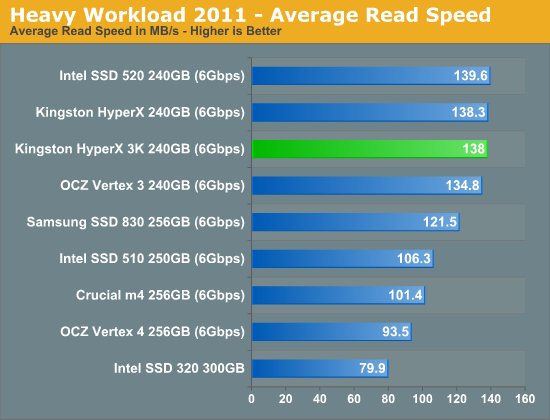
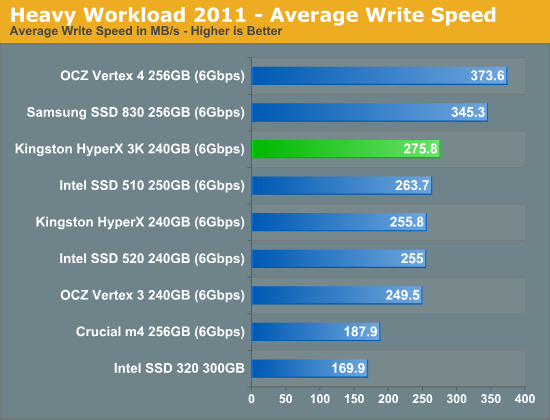
The next three charts just represent the same data, but in a different manner. Instead of looking at average data rate, we're looking at how long the disk was busy for during this entire test. Note that disk busy time excludes any and all idles, this is just how long the SSD was busy doing something:
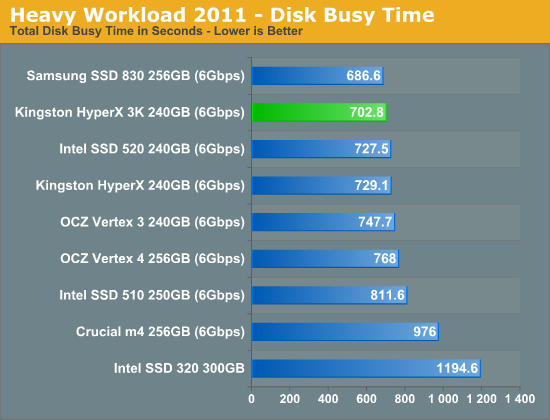
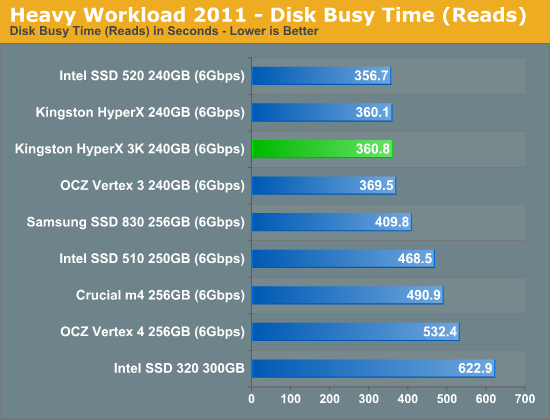
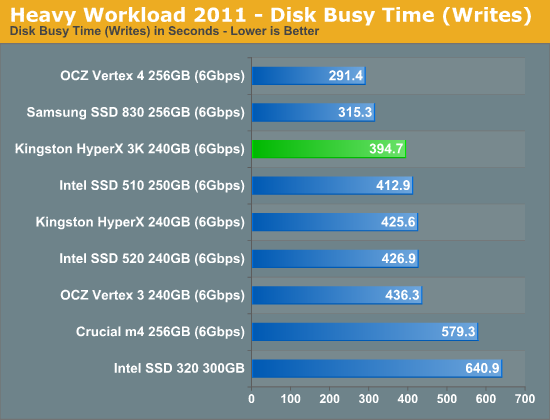


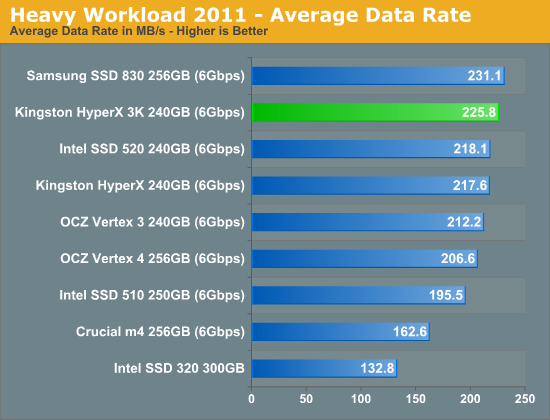








44 Comments
View All Comments
colonelclaw - Tuesday, April 10, 2012 - link
Just out of interest, when you talk about filling the drive and then 'TRIMing the drive', how exactly do you do this? I thought TRIM was automatic (in the right OS), or is there some command that can be run to 'TRIM' a drive?Coup27 - Tuesday, April 10, 2012 - link
In Windows 6, TRIM is triggered when a file is actually deleted, so a format, empty the recycle bin or shift+del a file. When AT test SSDs they are connected as a storage drive, so it is easy to torture the drive and then TRIM it by formatting it within disk management.Coup27 - Tuesday, April 10, 2012 - link
^ Windows 7.Aside from that, Intel and Samsung have toolbox programs which allow you to manually force a TRIM and GC pass.
colonelclaw - Tuesday, April 10, 2012 - link
Thanks Coup!hrrmph - Tuesday, April 10, 2012 - link
BIG THANKS for including the information that it has a toolbox and that the toolbox doesn't support secure erase!hechacker1 - Tuesday, April 10, 2012 - link
What's Kingston's warranty on this? That lets me know about what they expect in terms of support.itsmepj - Monday, May 28, 2012 - link
fast is fast.. but not reliable..... i bough mine in Jan 2012... last week sent back for warranty, cannot detect..... all data gone.... yet replacement unit have to wait for 4-8 weeks time from Taiwan.... very bad backup service..... sadkillabee_me - Saturday, June 2, 2012 - link
I would love to see Anandtech review Sandisk Extreme SSD 240GB .The word is that Sandisk managed to fix one of the biggest problems with Sandforce - the TRIM actually works 100% and the performance is back to the advertized one even after hours of torture tests with incompressible data.
In addition the Extreme series use a very fast SanDisk's own 24nm Toggle Mode NAND and a custom optimized firmware, which results in one of the fastest SSD on the market. The price is extremely competitive as well.
It would be interesting to see what it can do in AnandTech Storage Bench.
phillyry - Tuesday, August 7, 2012 - link
Anand,Why have you assumed a write amplification of 10x ?
Looking at xtremesystems dot org forums for SSD-Write-Endurance-25nm-Vs-34nm, it appears that 1x seems more common (with only the Samsung 470 showing 5x).
Are these stress tests unrealistic and therefor somehow lowering write amplification?
Could you please provide some insight as to how you came up with this figure.
I thought that most SF and Micron based drives had write amp neer 1.0
RSVP,
phillyry
starcom - Tuesday, November 20, 2012 - link
In the end, I buy the HyperX or HyperX 3K?